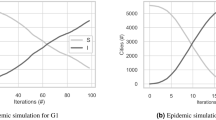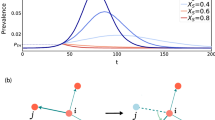Abstract
The term Silk Road was created in the Middle Ages for a rather low spectrum of streets (roads) being used to transport goods from China to Europe and back, passing different cultures. However, not only goods had been and are still today (intensively) spread along this pathway, but also agents of (often) severe diseases. Thus, constant control systems have to be established and permanently controlled with respect to their efficacy. Today, it takes only a few days (if not hours) until persons, goods, and agents of diseases are transported from one continent to the other. The old and the present pathways are enlarged daily, thus increasing the worldwide network.
Access provided by Autonomous University of Puebla. Download chapter PDF
Similar content being viewed by others
Keywords
- Cultural and economic spread
- Pathways of wandering diseases as severe epidemics
- Control measurements
- Worldwide transportation of agents of diseases by cars
- Ships
- Planes
The precursors of the recent mankind on earth apparently started their successful leadership in rather small groups, which had been able to adapt themselves to the changing of living conditions in special regions, which forced them to develop capacities to get sufficient food for the slowly but continuously growing mankind. This afforded that mankind had to organize a constant spreading of groups, which finally settled on all continents. Wandering human groups and their contacts with animals, which mostly had been ingested in a raw or poorly cooked status, helped to spread permanently a broad spectrum of agents of diseases among groups of many persons and animals. Since the temperatures varied on the different continents, humans started very early contacts with other humans in other regions of their own continent and in other ones. This led to the fact that in former centuries agents of diseases were easily spread potentially in a few months and today even within a few days. Since at the beginning the symptoms of infections are mostly rather low-graded and thus mostly not noted immediately, agents of diseases had and have significant changes to become easily spread—especially in countries where many people live close together.
1 Examples of Agents of Selected Diseases along the Silk Roads and further Related Sites
Thus, the spreading of humans (sensu stricto “homo sapiens”) around the globe led to the fact that also agents of diseases are spread, often leading to high death rates among people in regions where people had not been infected before. The increasing business contacts between people in Eastern, Western, Northern, and Southern regions on earth induced the spreading of severe, often fatal diseases. Thus, it was not astonishing that different and often severe diseases become spread via business activities from continent to continent. Some of them had been spread in special periods as shown below:
-
Cholera: ~1500 BC in China.
-
Tuberculosis: ~730 BC in Palestine.
-
Plague of Justinian: ~600–750 AD in Palestine.
-
Plague in Europe (1347–1353) killing about one-third of the population.
-
Repeated plague epidemics: e.g., fifteenth century in Germany, sixteenth century in Southern Europe, seventeenth century in Italy and England, fifteenth century in France, nineteenth century in India and surrounding regions, 1910–1911 in Manduria, 1946–1947 in Algeria and later single case imported, but individually treated in Europe.
-
So-called “large plague” (1615) starting in London and spreading from there to Europe.
-
Plague also occurred in countries in East and North Europe in 1707–1713.
-
So-called Indian Ganges-Brahmaputra pandemic spreading in whole Asia (1817–1823).
-
Second large cholera pandemic (1826–1837) in various countries in America, Europe, North Africa, and Asia.
-
Plague epidemic in China (1855) growing up to a worldwide pandemic.
-
Repeated plague epidemics starting in 1885 and spreading into Europe and America.
-
1865–1896: fourth and fifth cholera pandemic
-
1892: Cholera epidemic in Hamburg, Germany
-
1894–1912: Worldwide plague pandemic in countries in Asia, Europe, and North and South America
-
1918–1920: Influenza pandemic (Spanish flu): about 30 million death cases in Europe
-
1918: Spotted fever in Russia
-
1957–1958: Asian flu (A-H2N2)
-
1961: Start of the seventh cholera pandemic, which is still ongoing today
-
1976: First Ebola epidemic in Zaire
-
1980: Starting of the HIV epidemic in the USA
-
1991: Cholera epidemic in the whole of South America
-
2002–2003: Starting of the SARS pandemic
-
2008: Broad dengue fever in Brazil (~300,000 cases per year)
-
2009: So-called Pig flu, still spreading in recent times
-
2015: Zika virus epidemic started in its homelands, spread from there to Brazil, and endangered in the year 2016 also the visitors of the Olympic Games.
2 The Shrinking of our Recent World by Enlarging the Former Straits
In the Medieval times, the human world population started increasingly to get into closer contact, whereby goods, culture, and also agents of diseases became spread over the continents. At this time, it was much easier to transport large amounts of goods back and forth on streets stretching from Europe to Asia than across the oceans. However, this type of transport took time, so people got in contact with local people and thus with local agents of diseases, leading to several epidemics (e.g., plague) spreading in both directions. Today, the longest flights may require less than 24 h. Thus, diseases (e.g., plague, coronavirus) can be spread unnoted in many countries. On the other side, helpful goods and new knowledge can be distributed in a few days.
The transportation and exchange of many products were done from Europe to China and back. Since, at this time, one of the transported goods had been silk or silk products, all relevant streets had been named Silk Road. This name is still used today, although many more or less parallel streets are actually available to transport goods from the East to the West and back (Fig. 1.1). Since large and economically powerful countries like China, Korea, and India detected African countries and other regions as a growing markets, especially China has developed further “Silk roads” to transport huge amounts of products to Africa and along the African coast to Europe (Fig. 1.1).
Diagram of actual existing and planned “Silk roads” connecting Asian, African, and European countries enabling quick product exchanges in both directions (Shenzen City planning exhibition): routes by train and routes by ship. P.S.: There are also existing “roads” passing Africa from the South to the Mediterranean coast
The “land-based part of the silk road” (line Shenzhen, China—Duisburg, Germany), which actually covers at least 60 trains per week passing Lanzhou, Almaty, Tashkent, Teheran, Istanbul, Moscow, and Duisburg, is expanding. From there, goods are transported to the Netherlands and Venezia, which is also reached by ships sailing via the South road along East Africa (Fig. 1.1). Thus, both “New Silk Roads” connect by their back and forth activities (via trains and ships) Africa, Asia, South East Asia, and Europe and thus increase the benefits for all countries along their routes. The inclusion of African countries into the activities of Asia and Europe is especially important since many of these countries suffer from the ongoing lack of connections to the rest of the world, although their economic potential is large.
Further Reading
Barbieri R, Signoli M, Chevé D, Costedoat C, Tzortzis S, Aboudharam G, Raoult D, Drancourt M (2020) Yersinia pestis: the natural history of plague. Clin Microbiol Rev 34(1):e00044–e00019
Barnes AM, Quan TJ, Poland JD (1985) Plague in the United States, 1984. MMWR CDC Surveill Summ 34(2):9SS–14SS
Benedictow OJ (2004) The black death (1346–1553). The complete history. Boydell Press, Woodbridge, UK, pp 3–67
Bos KI, Schuenemann VJ, Golding GB, Burbano HA, Waglechner N, Coombes BK, McPhee JB, DeWitte SN, Meyer M, Schmedes S, Wood J, Earn DJ, Herring DA, Bauer P, Poinar HN, Krause J (2011) A draft genome of Yersinia pestis from victims of the black death. Nature 478:506–510
Bramanti B, Dean KR, Walløe L, Chr Stenseth N (2019) The third plague pandemic in Europe. Proc Biol Sci 286(1901):20182429
Bramanti B, Stenseth NC, Walløe L, Lei X (2016) Plague: a disease which changed the path of human civilization. Adv Exp Med Biol 918:1–26
Demeure CE, Dussurget O, Mas Fiol G, Le Guern AS, Savin C, Pizarro-Cerdá J (2019) Yersinia pestis and plague: an updated view on evolution, virulence determinants, immune subversion, vaccination, and diagnostics. Genes Immun 20:357–370
El-Bassel N, Gilbert L, Shaw SA, Mergenova G, Terlikbayeva A, Primbetova S, Ma X, Chang M, Ismayilova L, Hunt T, West B, Wu E, Beyrer C (2016) The silk road health project: how mobility and migration status influence HIV risks among male migrant workers in Central Asia. PLoS One 11(3):e0151278
Glatter KA, Finkelman P (2021) History of the plague: an ancient pandemic for the age of COVID-19. Am J Med 134(2):176–181
Grüntzig J, Mehlhorn H (2010) Expeditions into the empire of plagues. Düsseldorf University Press, Düsseldorf
Haruda AF, Ventresca Miller AR, Paijmans JLA, Barlow A, Tazhekeyev A, Bilalov S, Hesse Y, Preick M, King T, Thomas R, Härke H, Arzhantseva I (2020) The earliest domestic cat on the silk road. Sci Rep 10(1):11241
Hay J, Yeh KB, Dasgupta D, Shapieva Z, Omasheva G, Deryabin P, Nurmakhanov T, Ayazbayev T, Andryushchenko A, Zhunushov A, Hewson R, Farris CM, Richards AL (2016) Biosurveillance in Central Asia: successes and challenges of tick-borne disease research in Kazakhstan and Kyrgyzstan. Front Public Health 4:4
Kitasato S (1894) The bacillus of bubonic plague. Lancet 2:428–430
Kurdoglu O, Kurdoglu BC (2010) Determining recreational, scenic, and historical-cultural potentials of landscape features along a segment of the ancient silk road using factor analyzing. Environ Monit Assess 170(1–4):99–116
Liu X (2010) The silk road in world history. Oxford University Press, Oxford
Liu Z, Wang C, Wei K, Zhao Z, Wang M, Li D, Wang H, Wei Q, Li Z (2021) Investigation of genetic relatedness of brucella strains in countries along the silk road. Front Vet Sci 7:539444
Matero P, Pasanen T, Laukkanen R, Tissari P, Tarkka E, Vaara M, Skurnik M (2009) Real-time multiplex PCR assay for detection of Yersinia pestis and yersinia pseudotuberculosis. APMIS 117(1):34–44
Mehlhorn H (2016a) Human parasites. Diagnosis, treatment, prevention, 7th edn. Springer International Publishing, Switzerland
Mehlhorn H (2016b) Encyclopedia of parasitology, 4th edn. Springer, Berlin, London, New York
Namouchi A, Guellil M, Kersten O, Hänsch S, Ottoni C, Schmid BV, Pacciani E, Quaglia L, Vermunt M, Bauer EL, Derrick M, Jensen AØ, Kacki S, Cohn SK Jr, Stenseth NC, Bramanti B (2018) Integrative approach using Yersinia pestis genomes to revisit the historical landscape of plague during the medieval period. Proc Natl Acad Sci U S A 115(50):E11790–E11797
Sebbane F, Lemaître N (2021) Antibiotic therapy of plague: a review. Biomol Ther 11(5):724
Woźniacka A, Jurowski P, Omulecki A, Kot M, Dziankowska-Bartkowiak B (2014) Behçet's disease leaves the silk road. Postepy Dermatol Alergol 31(6):417–420
Yang R (2017) Plague: recognition, treatment, and prevention. J Clin Microbiol 56(1):e01519–e01517
Yeh HY, Mao R, Wang H, Qi W, Mitchell P (2016) Early evidence for travel with infectious diseases along the silk road: intestinal parasites from 2000 year-old personal hygiene sticks in a latrine at Xuanquanzhi Relay Station in China. J Archaeolog Sci Rep 9:758–764
Yersin A (1894) La peste bubonique à Hong-Kong. Ann Inst Pasteur 8:622–667
Author information
Authors and Affiliations
Corresponding author
Editor information
Editors and Affiliations
Rights and permissions
Copyright information
© 2023 The Author(s), under exclusive license to Springer Nature Switzerland AG
About this chapter
Cite this chapter
Mehlhorn, H. (2023). Network Expansion and Disease Spread along the Former and Present Straits of the Silk Road(S) and Other International Straits. In: Mehlhorn, H., Wu, X., Wu, Z. (eds) Infectious Diseases along the Silk Roads. Parasitology Research Monographs, vol 17. Springer, Cham. https://doi.org/10.1007/978-3-031-35275-1_1
Download citation
DOI: https://doi.org/10.1007/978-3-031-35275-1_1
Published:
Publisher Name: Springer, Cham
Print ISBN: 978-3-031-35274-4
Online ISBN: 978-3-031-35275-1
eBook Packages: Biomedical and Life SciencesBiomedical and Life Sciences (R0)





